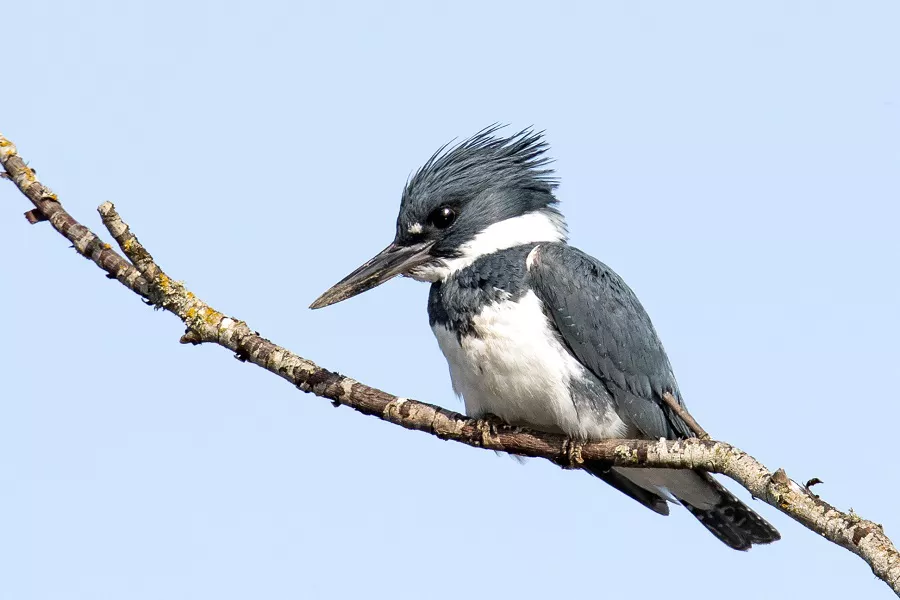The fascinating world of avian migration has captivated scientists and bird enthusiasts for centuries. Birds, with their innate ability to traverse vast distances, have evolved various strategies to adapt to changing environments. One such remarkable species is the belted kingfisher (Megaceryle alcyon). Known for its distinctive appearance and vibrant call, this medium-sized bird raises a question: Do belted kingfishers undertake migratory journeys? This article delves into the migratory behaviors of belted kingfishers, shedding light on their seasonal movements and the factors influencing their patterns.
Belted kingfishers are widespread across North America, inhabiting both freshwater and saltwater environments such as rivers, lakes, estuaries, and coastlines. These birds, characterized by their shaggy crests, blue-gray plumage, and white underparts, are well-adapted to their aquatic lifestyle. Their diet primarily consists of fish, which they capture by diving from perches or hovering above water bodies.
Migratory Patterns and Timing:
Unlike many other bird species, belted kingfishers exhibit complex and diverse migration patterns. While some individuals are sedentary and remain in their breeding territories year-round, others embark on migratory journeys. The extent of migration varies within different populations and is influenced by factors like food availability, climate, and habitat suitability.
In North America, belted kingfishers breeding in more northern regions, such as Canada and Alaska, are known to migrate southward during winter. They travel to more temperate regions in the southern United States, Mexico, and Central America, where food resources are relatively abundant. Populations breeding in milder southern regions may exhibit shorter-distance movements or even remain resident throughout the year.
Migration Routes and Navigation:
The migratory routes of belted kingfishers are not as extensively studied as those of some other bird species. However, researchers have observed interesting patterns by tracking individuals using radio telemetry and geolocator devices. It appears that belted kingfishers often follow linear routes during migration, utilizing major water bodies such as rivers, coastlines, and large lakes as navigational guides.
The ability of these birds to navigate accurately over vast distances is still a subject of investigation. Like many migratory birds, they likely rely on a combination of celestial cues, landmarks, magnetic fields, and innate genetic programs to navigate successfully. Further research is needed to unravel the exact mechanisms behind their exceptional orientation skills.
Factors Influencing Migration:
Several factors influence the decision of belted kingfishers to migrate or remain resident. Food availability plays a crucial role, as these birds heavily rely on fish as their primary food source. In regions where water bodies freeze during winter, kingfishers may be forced to migrate to areas with open water, ensuring a continuous supply of prey.
Climate also influences migration patterns, as temperature changes affect both food availability and suitable breeding habitats. Belted kingfishers generally prefer to nest in burrows along eroded banks, which can be affected by fluctuations in water levels and habitat degradation. Consequently, alterations in climate patterns might impact the timing and extent of migration among belted kingfisher populations.
Conservation Considerations:
Understanding the migratory behaviors of belted kingfishers is essential for effective conservation efforts. These birds face various threats throughout their range, including habitat loss, pollution, and climate change. Protecting key stopover sites along migration routes and preserving breeding habitats is crucial to ensure the long-term survival of belted kingfisher populations.
Additionally, promoting sustainable fishing practices and maintaining healthy aquatic ecosystems are vital for providing an adequate food supply for these birds. Collaborative initiatives between researchers, conservation organizations, and policymakers can contribute to the conservation of belted kingfishers and other migratory species.
Conclusion:
In conclusion, while some belted kingfishers are sedentary year-round residents, others undertake remarkable migratory journeys. Migration patterns within this species vary across different populations and are influenced by factors such as food availability, climate, and habitat suitability. By unraveling the mysteries of belted kingfisher migration, we gain valuable insights into their ecological adaptations and the challenges they face in an ever-changing world. Conservation efforts aimed at protecting their habitats and ensuring the sustainability of their food sources are crucial for the continued survival of these captivating birds.


 Facebook
Facebook  Instagram
Instagram  Youtube
Youtube 